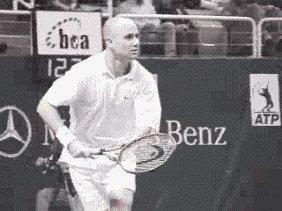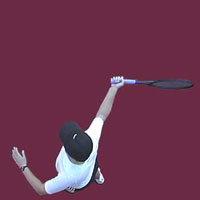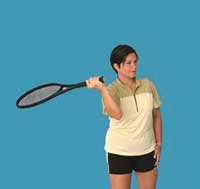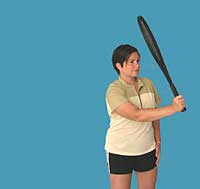
Designing a New Stroke
By Ray and Becky Brown
For several years, Becky and I have watched highly ranked satellite and
challenger players struggle against lesser skilled players who would throw
up a high ball as a defensive measure when they were behind, or just as a
strategy to win. In Boca Raton one year we watched as an unranked high
school player (playing their first professional event) knock off a seeded
player ranked in the 500's by mainly hitting a high ball down the middle
until her opponent crashed in frustration. We were really surprised to see
that the more skilled and experienced, seeded player was completely
neutralized by this ball. Try as she may, it was impossible for her to
defeat the high ball strategy.
|

Agassi's elbow position while hitting on the run is a significant
factor in the consistency of this shot. |
This situation, which persists today in the women's game except at the
highest levels, provides a good example of when a coach might like to
design a new stroke to improve their player's chances of going up in the
rankings.
As another example, suppose you have a highly skilled player that is
losing to lesser skilled players because when they become too nervous they
consistently put the ball in the net. There are numerous scenarios like
these when a coach can become proactive and make a significant difference
in their player's progress.
We recently decided to specifically analyze the problem the
high-ball-down-the-middle posed and develop an offensive countermeasure.
Thus we developed the type I and type II high forehands, which can quickly
put an end to this type of rally.
In the process, we developed a general method of designing new strokes
and tested the method by teaching it to some of our Pros to see if they
could do it also. We were pleased to see the method could be passed on
without great difficulty. In this article, we explain this method which we
have subsequently used to design a wide variety of new strokes for
professional players, amateurs, and handicapped players as well.
A specification for any tennis stroke
We began by determining that a tennis stroke must have three
properties, in varying combinations, in order to be effective. These three
properties are: 1) a means of providing stability to assure the stroke can
be controlled at its preferred speed; 2) a means of producing racquet
speed; 3) a means of maximizing the probably of an optimal kinetic
exchange between the racquet and ball. Any stroke having all three
properties will likely be useful. In addition, its purpose and application
should be very clear if the player employing the stroke is not to become
confused under pressure.
If these are the properties of a good tennis stroke, then what are some
of the ways these properties are manifested in the stroke? We now present
examples to illustrate each property.
Stability
What we mean by stability is that small variations in the circumstances
of the stroke do not result in the stroke becoming unpredictable. For
example, if it becomes necessary to design a new variation on the
forehand, the elbow position is a key to stability. So, if a player
prefers a severe western grip as many women do, the elbow must be well in
front of the body before rotation, otherwise the elbow will likely fly out
away from the body causing the face of the racquet to turn downward See
the three frame sequence in Figure 1 below for an example of an unstable
version of the western forehand. In this sequence, the elbow has started
even with the body plane so that as the rotation starts, the racquet face
turns downward usually sending the ball into the net.
  
Figure 1: An unstable elbow results in an unpredictable stroke. |
However, if the new stroke requires very little or no body rotation,
the elbow position is less critical to stability. An occasion when
elimination of rotation makes sense is when the player is so nervous at
the start of a match they cannot bring themselves to turn sideways, and
thus are always facing the opponent. As another example, if the stoke you
have in mind must be hit on the run, then considerable care must be taken
to design the elbow position to ensure stability or the forces acting on
the racquet caused by running could result in a wide variation in the ball
trajectory.
Stability is a complex property of stroke dynamics and so to work out a
stroke that is stable, one may have to go through a process of
trial-and-error. The key to stability in most cases, as we have mentioned,
is the elbow placement and its proximity to the body. For example,
movements where the elbow is close to and in front of the body are more
stable than those where the elbow is beside or behind the body at the
start of the rotation stage.
|

By combining leg, hip, shoulder, and forearm rotation Agassi is
able to generate sufficient power to hit winners from the baseline. |
Power
The second feature of an effective stroke is a source of power. This
means the stroke must have some means of accelerating the racquet up to a
useful velocity. This is the hardest specification to satisfy because the
means available to the human body to develop racquet speed are very
limited.
In general, the easiest source (but not the only source) of racquet
speed is some form or rotation. By observing someone throwing the discus
we can see that rotation can produce great speed. Thus we look to the
available sources of rotation in the human body: the hips, shoulders, and
arm.
Since a stroke should be as simple as possible, and no simpler, to
paraphrase Einstein, start with the hips or shoulder to see if they are
sufficient to produce the desired speed. This process, just as with any
engineering design, may require some trial-and-error experimentation.
Among the sources of efficient racquet velocity is the upper arm rotation.
Many players have discovered this source of power, particularly female
flat ball hitters. However, Agassi is a master of using it to produce high
ball velocity.
Maximizing the probability of a clean contact
The final specification is for increasing the probability of clean
contact with the ball or a clean kinetic exchange. This is the easiest
specification to satisfy. Any movement that will cause the racquet to move
nearly in a straight line near the time of contact will satisfy this
specification. The reason this increases the probability of a clean
exchange of energy between the racquet and ball is that a straight line is
the easiest geometrical shape for our brains to work with. Every other
shape is harder to employ.
At this point we discover a contradiction in the human makeup. While
straight lines are easy to produce and control, they are not natural
movements. Circular movements are more natural and are more likely to be
employed in swinging a tennis racquet, partly because this is one way to
produce racquet speed. But there are biological reasons why we naturally
make circular movement as well. Anyone watching a child swing a racquet
for the first time has observed how engrained and natural the circular
swing is.
| One very subtle source is combining two rotations
to make a straight line. For example, rotating the shoulders and the
arm simultaneously can create a nearly straight line motion (See the
figure 2 on the right).
The large circle represents the circle of rotation of the body
while the small circles represent the circle of rotation of the arm
relative to the body.
If the body were not rotating, all three circles would coincide.
The three small lines represent the racquet, they are all the same
length. |

Figure 2: A near-straight line can be produced by combining body
rotation with arm rotation. |
The easiest and most traditional source of straight line motion is
produced by using the legs to shift our weight from the back foot to the
front foot without lifting either foot. When coaches encourage students to
step into the ball, this is one of the benefits they are seeking to
teach. It is a misconception to think the force of stepping into the ball
produces the resulting ball speed. It can be shown the increase in
ball velocity due to stepping forward is about 2 miles per hour. However,
the increase in velocity due to causing the racquet to move in a straight
line into the ball (resulting in a clean exchange in energy between the
racquet and ball) can be in excess of 10 miles per hour.
It is also possible to use arm rotation in conjunction with body
rotation to produce a nearly straight line interval. Why this is possible
is illustrated in Figure 2 above.
  
Figure 3: (1) Stabilize the elbow, (2) rotate the upper arm for
power, and (3) extend the shoulder and forearm to obtain a straight
line motion at contact. |
Now that we have set forth the basic specifications for a stroke, lets use
them to develop a high forehand using a western grip.
A high forehand is one which the ball bounces above the shoulders but is
too low for an efficient overhead. In particular, we will design what we
have called the Type II high forehand. Below are three frames (Figure 3)
illustrating the type II high forehand.
Stability comes from the elbow placement in front of the body plane as
seen in the far left frame. The racquet speed comes from the upper arm
rotation (the upper arm is roughly, but not exactly, parallel to the court
as seen in the middle frame).
|

In this animation, Becky has eliminated the leg and body components
in order to provide the simplest illustration of the three key
elements of a high forehand. |
In Figure 3, we have eliminated the body and leg movements to isolate
the arm movements. Once the arm movements are understood, one may add
other factors as desired.
The straight line interval is provided by forearm extension from the
elbow joint as seen in the far right frame. Below is an animation that
puts these three segments together as a single stroke.
In general, when designing new strokes, design the minimal stages
needed and allow the student to adapt or develop variations on the stroke
that fit their skill level and personality.
It is generally a good rule to
get the student involved in the design and experimentation process at the
start and avoid imposing ridged rules.
Also, when designing a stroke for a student, child, or handicapped
individual, first observe their natural tendencies or limitations and
utilize these whenever possible. This will greatly accelerate the learning
process.
Your comments are welcome. Let us know what you think about Ray and
Becky Brown's article by emailing us
here at TennisONE.
Ray and Becky Brown are the founders of EASI
TennisTM. The EASI
TennisTM System is a new and
revolutionary method of teaching stroke technique that can dramatically
reduce the time needed to learn to play master, or any level, of tennis.
To learn more about the EASI TennisTM
System,
click here.
 Ray
Brown, Ph.D. Ray
Brown, Ph.D.
Over the past ten years Ray Brown has been working in the area of
neuroscience and brain dynamics. During this time, he has conducted
extensive experiments in conjunction with his wife to determine whether
neuroscience can be applied to dramatically accelerate tennis training.
Dr. Brown received his Ph.D. in mathematics from the University of
California, Berkeley in the area of nonlinear dynamics and has over 30
years of experience in the analysis of nonlinear systems. He has published
over 20 articles on tennis coaching and player development and over 35
scientific papers on complexity, chaos, and nonlinear processes.
 Becky
Brown, M.S. Becky
Brown, M.S.
Using the new training methods developed in research with her husband,
Becky Brown went from a USTA NTRP tennis rating of 3.5 to a professional
world ranking of 1,069 in less than four years. Prior to the inception of
this neuroscience research, Becky Brown had no previous high school,
college or professional experience in tennis. Ms Brown received her M.S.
in applied mathematics from Johns Hopkins University and has over eighteen
years experience in the development of high technology defense systems.
With her husband she has co-authored numerous articles on tennis training
and coaching. |